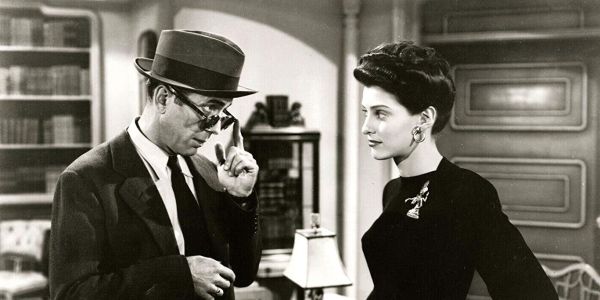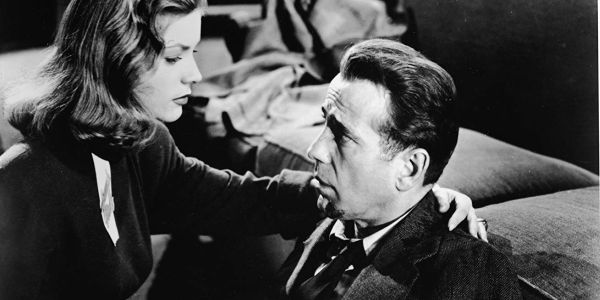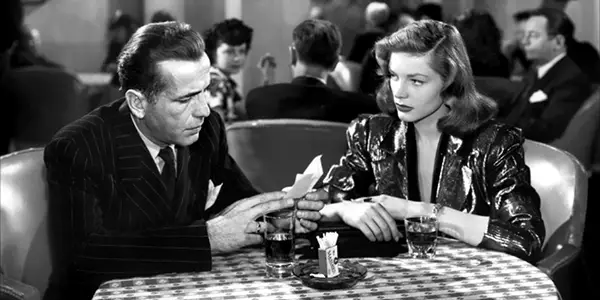Why THE BIG SLEEP Still Enchants At 75

Alex is a film addict, TV aficionado, and book lover.…
The film noir The Big Sleep wouldn’t exist without a spark. Yes, I mean the real-life one between its stars Humphrey Bogart and Lauren Bacall, but also the one they share onscreen in their first meeting, the seduction by way of cigarette in To Have and Have Not. The casual request for matches from Bacall, the perfect toss from Bogart, and the strike that produces the flame. Barely a word is spoken yet we’re all with their poor scene companion Marcel Dalio, eyes pinballing between the two as if their connection will sever anyone who comes between them.
If those two hadn’t fallen in love onscreen for the world to see in that film, then The Big Sleep wouldn’t have been rushed into production and Raymond Chandler’s hard-nosed private eye novel wouldn’t have been warped into a co-starring vehicle for the legendary couple that has steamed and perplexed people for the last 75 years.
That it holds together at all—let alone became one of the greatest film noirs of all time—is perplexing even in hindsight, perhaps more so now that we have a clearer picture of its chaotic production. An unfinished script, an ailing star, a director with creditors breathing down his neck, and a real-life love triangle is enough to derail even an uncomplicated production, and any adaptation of Chandler’s risqué novel was going to be difficult to get past the era’s Production Code. And yet director Howard Hawks, as was his wont, turned it into a massive hit despite all the distraction.
Many have noted (including on this very site) that The Big Sleep has a certain postmodern or camp-adjacent sensibility, a “no plot, just vibes” approach to a genre that’s supposed to be powered by an unraveling mystery. But if there’s a single thing The Big Sleep is notorious for it’s the incomprehensibility of its plot, with the initial blackmail case taken on by the c*cky Philip Marlowe spiraling to include multiple murders and more sex, drugs, and rock ‘n roll (or at least Bacall crooning a jazz standard) than anyone could track.
So, how does the noir that broke all the rules capture so many hearts? Bogart and Bacall are a huge factor, of course (we’ll get to them later), but there’s also the near perfect match of storyteller and story that allowed Hawks to turn the nearly impossible adaptation into a lasting classic.
The Man, The Myth, The Legend
If there’s one thing to understand about Hawks, it’s that he was a liar. To trust anything he said, whether at a party or a formal interview, is complete folly, his need to be the best and brightest in the room leading him to spin even his greatest failures into successes. That everyone knew he did it and still loved him (so much so that Cary Grant would call Peter Bogdanovich after Hawks’ death just to hear his spot-on impression of the man they both adored) clues you in on just how good he was at spinning yarns, a talent that unsurprisingly spilled over into his films.

He made just about every kind of movie under the sun, had numerous hits, and came to be appreciated critically (if the highly influential French film magazine Cahiers du Cinéma overvalued auteurs, at least they used their silly standards to champion Hawks). The Big Sleep is his noir masterpiece, but noir as a genre isn’t the most natural fit for his strengths. Most luxuriate in the mystery, hook you in with strange details, and twist and twist until things simply must be unraveled. Hawks also loved to luxuriate, but on a pretty woman or men being dudes, his hook being snappy dialogue that brimmed with double meanings. So he morphed The Big Sleep, deemphasizing the labyrinthine plot that requires most noirs to stop periodically and recap events to focus on the things he was interested in: the white-hot flame of new love and the no-nonsense excellence of a man on the job.
The latter is something he brought from his own life, as anyone who’s peeked at his filmography can attest. It’s impossible to produce so many legendary films without being damn good at it, but the extraordinary supremacy of Philip Marlowe allowed him to indulge his wildest fantasies about being a man always in control and constantly desired.
Chandler wrote Marlowe as a particularly bright if weary chap, his ability to navigate the tawdry world the case takes him through and suss out everyone’s motives being common traits among gumshoes. Where the film diverges is in making him sexually dominant as well as intellectually, with women throwing themselves at him after only a few moments in his presence. The cab driver who gives him her number and tells him to call her at night because she “works during the day” is original to the film, as is the extended meeting with a bookstore owner that leaves little question about what happened after she closed the store. Hawks’ Marlowe is, in many ways, the man he spun himself to be: the man who always has the upper hand and who always wriggles out of tough spots and into warm beds. It’s a fantasy so enjoyable that it’s understandable why he’d want to stay there forever, and why it keeps drawing in audiences.
That Notorious Plot
Tweaking the central character was hardly the only change The Big Sleep underwent from book to screen, despite the rather humorous directive Hawks gave to his screenwriters to not make many changes. Hawks always put his stamp on the material (hence the auteur label), and Chandler’s novel would be impossible to film with its central mystery pivoting around pornography and the sexually free youngest heiress of the Sternwood clan (one can imagine Joseph Breen, enforcer of the Production Code at the time, having an aneurism if the plot hadn’t been toned down).
The note from Hawks may have stemmed from a simple wish to get the production going quickly. He owed Warner Brothers another film and was under significant financial strife from unpaid taxes and gambling debts. With Chandler under contract with Paramount and hence unable to do the adaptation for Warner Bros, Hawks turned to an old buddy, some unknown guy named William Faulkner, to head the adaptation. Obviously, the acclaimed novelist and experienced screenwriter knew how to structure the story, even if large parts had to be kept vague to slide past the Code, but to keep the hard-boiled detective feel sharp and to make sure the script could be produced in a handful of weeks, he brought on a writer with only one novel to her name, Leigh Brackett.

The story goes that Hawks was surprised when a woman walked in, having assumed Leigh was a man’s name but plunged forward to form a director/writer partnership that would extend to four more films. And Hawks wasn’t the only one to have their sexist assumptions overturned by Brackett; when Bogart complained about moments that made Marlowe too soft, he was surprised to learn the sections were written by Faulkner, and Brackett became his go-to for line punch-ups throughout production.
Faulkner and Brackett would turn in a script in six weeks that had the most obviously offensive material excised and Bacall’s role as the elder but still naughty of the two heiresses beefed up (and they even managed to solve a murder that Chandler’s book never explained), but they hadn’t found an ending. Since Hawks liked to shoot in sequence and rewrite as he went this didn’t stop things from moving forward, but the scramble to complete a script and then tweak things to lead into an ending that was in flux almost certainly led to some of the film’s looseness, no matter how brilliant the writers were.
In fact, many of the most famous scenes from the final product weren’t even in this shooting script, with some not coming until after the film’s main production finished and test screenings were conducted. The Big Sleep wrapped its initial shoot in January 1945 and sat for over a year as Warner Bros prioritized getting war films out before World War II ended, and this time gave all involved the room to evaluate just what was missing from a cut that wasn’t the slam dunk they’d expected. This flawed version was restored and included in recent releases, and in comparing that cut to the final masterpiece, one finds that the impenetrable plot that naysayers complain about in The Big Sleep is precisely what was formed.
The 1945 cut is much more in line with noirs of the time, complete with a pause to summarize the plot partway through and generally leaning much more on the mystery than the spark between Bogart and Bacall. Remember how Faulkner and Brackett wrote an explanation for one of the story’s many murders? They were forced to do that when Bogart, Hawks, and Chandler all admitted they didn’t know who murdered the family’s chauffeur, Owen Taylor, and they worked it into a scene where Marlowe meets with the police for the classic plot rundown. This ended up being one of the biggest sections to be cut between the 1945 version and the film’s final release, one of many clear signs that they consciously abandoned keeping the plot coherent.
So don’t feel bad if you’ve never been able to piece together the mystery within The Big Sleep, because you aren’t really supposed to worry about it. Instead, the noir’s heart lies with Bogart and Bacall, whom this movie thrives upon.
Steam It Up
Nowadays the legend of Bogart and Bacall makes their pairing seem like a surefire recipe for success, but all of that was up in the air as The Big Sleep neared release. While Bogart was a steady star Bacall was still trying to establish herself, and recent stumbles made her place in the industry let alone in history suspect.
Her debut in To Have and Have Not had been a runaway success, thanks to her chemistry with Bogart and very careful molding from Hawks. Hawks’ wife Slim had pointed out the model to her husband, knowing that the man had a type. He signed the young woman and gave her exercises to move her closer to the headstrong Hawks-ian woman his films are known for, including having her lower her already deep voice to the husky tone that’s now infamous. His type was taken to the extreme in To Have, which yes, featured Bacall as a character so openly modeled on Hawks’ wife Slim that the character shares her nickname. Bogart’s character, affectionately called Steve, was also lifted from Slim’s real-life nickname for Hawks, and when you add in the clearly jealous behavior Hawks showed when Bacall was immediately drawn to Bogart, the relationship between the director and the romantic pair he created was full of enough gossipy intrigue to consume a production.

Yet everyone soldiered on and To Have, and Bacall herself became a hit. Warner Bros. figured the same trio would cement Bacall as a star in The Big Sleep, so much so that they eventually bought her contract from the ego-wounded Hawks (I told you, jealous). That made them alarmed when the early cut of The Big Sleep failed to sustain the spark and grew panicked when Bacall’s second release, Confidential Agent, bombed.
What was missing from the 1945 version was simply time between the two leads, because, for all the work Faulkner and Brackett put into expanding Bacall’s role from the novel, this was and always would be the story of Bogart’s Marlowe. The studio and filmmakers agreed on the fix, so whole scenes were reshot or created from scratch to add in as much sultry rapport as the story could handle.
The innuendo-laden centerpiece of the film, where they discuss horse racing but really sex, was inexplicably one of those additions. Imagine the film without this tone-setter, without so much of the hot and bothered sparring between Bogart and Bacall that powers you through the long stretches where Marlowe actually works the case. That’s what you get in the 1945 version, and the switch to play up the lightning-in-a-bottle that is Bacall’s embodiment of Hawks’ perfect woman opposite Bogart’s too cool-for-school detective saved the film.
Now, despite their obviously winning combination, shooting with Bogart, Bacall, and Hawks wasn’t exactly serene. Besides Hawks’ jealousy, Bogart and Bacall weren’t technically together during the bulk of filming The Big Sleep. Bogart was still married to his third wife, actress Mayo Methot, a pairing that elicited extreme drinking and fighting even without the added stress of a Bacall-shaped wedge. The two began an on-again, off-again affair while filming To Have, and Bogart, struggling to extricate himself from his marriage but unable to deny he and Bacall’s inevitability by the time filming on The Big Sleep rolled around, took his drinking to such excess that he briefly couldn’t work (a rarity for the hard-living star).
By the time everyone got around to fixing The Big Sleep’s underwhelming sexuality problem, Bogart’s marriage to Mayo was over and the one with Bacall had begun, the certainty of romantic failure mellowing out Hawks. This likely made no difference in the chemistry they captured onscreen (it was there from the start), but it almost certainly made finding the snap, crackle, and pop that drives The Big Sleep less tumultuous.
In retrospect, perhaps the rushed, troubled production would have sunk the film without the long delay that gave both studio and filmmakers time to hone in on the easy, real charm they had. Then again, one shouldn’t give the studio too much credit. Studio head Jack Warner passed down one of his most famous and incorrect notes during shooting: “Word has reached me that you are having fun on the set. This must stop.”
The Big Sleep, like so many of Hawks’ films, hinges on fun over everything else, and he knew how to put aside production problems and his own emotions to capture it onscreen. Warner must’ve realized this as well, having ultimately approved this most unique of approaches to film noir, and once it raked in big at the box office he could hardly argue. Fun in the form of a constantly outwitting and out-flirting Philip Marlowe is why The Big Sleep is a crowd-pleaser to this day, and with forgiveness to its baffling plot, is regarded as one of the best noirs of all time.
What do you like about The Big Sleep? Can you get past the plot and enjoy it for everything else it has to offer? Let us know in the comments!
Does content like this matter to you?
Become a Member and support film journalism. Unlock access to all of Film Inquiry`s great articles. Join a community of like-minded readers who are passionate about cinema - get access to our private members Network, give back to independent filmmakers, and more.
Alex is a film addict, TV aficionado, and book lover. He's perfecting his cat dad energy.













